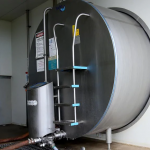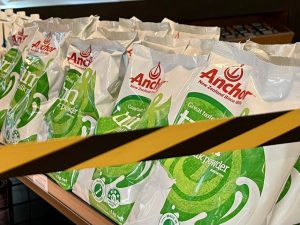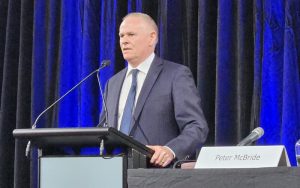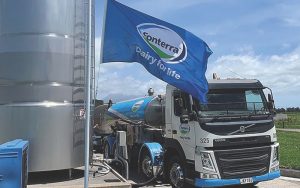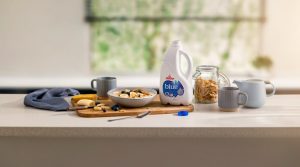
It’s approaching its annual report on September 12 amid talk that Fonterra’s crisis could become a farmers’ crisis – and ultimately New Zealand’s.
Levin sharemilker Richard McIntyre said there were no easy answers, even as some suggest the dairy giant could be split into two.
“Relying on milk processing to make powder and selling off non-performing assets is a good argument to make when commodity prices are high, but when they drop all of a sudden you become dependent on the value-add.
CHRIS MCKEEN/STUFF
Fonterra chief executive Miles Hurrell says more international assets are under review.
“I remember when commodity prices were low, there was a lot of gnashing of teeth because people said Fonterra hadn’t put enough into value-add,” McIntyre said.
As a sharemilker, he was not affected by the lack of a dividend, but he saw the impact on his farm owners who had seen a drop in land, cow, and share values in recent years.
Just two years ago there was little sense that Fonterra was heading for the financial rocks. But recently chief executive Miles Hurrell prepared the market for the worst.
He said New Zealand’s largest company expected to make a reported loss of between $590 million and $675m this financial year, taking into account likely writedowns.
Federated Farmers vice-president and Fonterra supplier Andrew Hoggard is more than a bit bewildered.
“I can remember a few years ago and the roadshows talking about the world domination thing – how did that come about because now it’s ‘turn the bus around completely and focus on New Zealand’.”
The fantasies of Fonterra taking over the world date back to its inception, when some forecast annual revenues of $40 billion, although they have never risen above $20b.
At the same time there were those who suggested it might end in tears, predicting production bungles, wasteful spending on offshore investments, multimillion dollar management salaries and high prices to farmers.
Next week, Hurrell will unveil Fonterra’s new strategy. What are its options?
* Split it into two: one, a milk processor and two, a consumer food service which becomes a 50:50 joint venture or listed entity;
* Create a “good” company of the bits that are successful, and a “bad” company that might include Soprole, DPA Brazil, China farms, Beingmate and Fonterra Australia, and try and rapidly sell the latter distressed assets;
* Hock off non-performing assets of the co-op bit by bit.
A director of TDB Advisory and himself a Fonterra supplier, Geoff Taylor, said the Northington report from last year lifted the lid on the accounts for the first time.
What it showed was that Fonterra made the most money out of processing milk and drying it, then shipping it to overseas markets.
“The good news is that it is a world class logistics processing company. The lowest risk is for them to process my milk here in New Zealand, suck the water out of it, put it on a ship and get a fair return. That consumes the least amount of my capital.”
MORNING REPORT/RNZ
Dairy farmers say the loss of any dividend this year will hinder growth and paying down debt.
That core business uses about 50 per cent of Fonterra’s capital. Anything else Taylor describes as “discretionary”.
He is quick to downplay notions of Fonterra or the industry being in crisis, citing its positive credit rating, high milk price, and very low costs of finance.
But it goes against the grain to hear of Fonterra turning its back on the “value-add” mantra.
It depends on your definition of value-add, says Fonterra Shareholders’ Council chairman Duncan Coull.
“The Northington report suggested we haven’t been great at adding anything to our core ingredients business since inception. To me it’s about shifting volume into value as quickly as possible, and emphasising its New Zealand provenance.”
Economist Peter Fraser told RNZ that while Fonterra had not entered into a “death spiral” yet, at some stage it would reach a point of no return.
“The first thing is do you have a rotten balance sheet – Fonterra has a rotten balance sheet. Secondly do you pay your farmers too much for their milk – Fonterra pays its farmers too much for their milk. The third part is because you pay your farmers too much for milk, you can’t fix your balance sheet by recapitalisation – you’ve got to go and sell stuff – and once you’ve sold everything you’ve got nothing left.
“That’s when we get to the fourth stage, and the fourth stage – the fourth stage is where Westland got to – is that they started losing milk supply and once they started losing milk supply, they’ve got empty factories, it all starts turning bad very, very fast.”
He said the writedowns might not be enough to forestall disaster for the co-operative.
Neither Taylor nor Coull share Fraser’s doomsday scenario, although they agree on the need for change.
By one measure – its present share price of $3.33 – Fonterra has hit rock bottom and it is likely to remain low until there is more confidence about the strategy.
A farmer with the average herd size of 431 cows, producing 158,000 kilograms of milksolids a year, would pay $526,140 for Fonterra shares today, whereas at the beginning of 2018 the price would have been over $1m.
When it released its interim report, Fonterra heralded a number of “emerging themes” which would be addressed in its strategy review, including a move to value from volume, prioritising New Zealand milk production, and an increased focus on return to capital.

